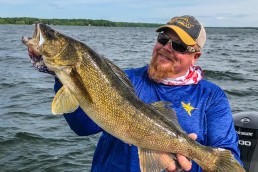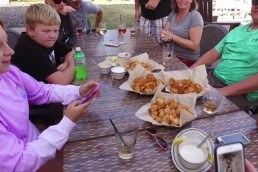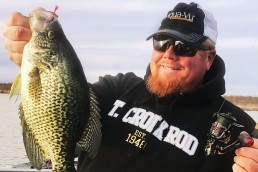Midsummer Walleyes, Hot and Cold
SHARE THIS POST
August can be hot like summer or cool like fall. It usually starts out much like July and finishes much like September, with water temperatures beginning in the upper 70s, then falling into the 60s by the end of the month.
If the summer has been hot, many of the fish can be forced into shallower water to find good oxygen levels by the time August arrives.
If it’s been cool summer, then the lakes may not reach their maximum water temperatures until early August, and oxygen levels won’t be nearly as big of a limiting factor for the fish later in the summer.
Surface temperatures
Most years, surface water temperatures in the lakes in my part of the country will reach into the high 70s more than once during the summer, as air temperatures fluctuate and weather patterns change.
Surface water temperatures in the low 80s are rare, with water temperatures in the 80s only lasting a few days in most situations. A long period of surface water temperatures in the low 80s will cause a summer kill on the cold-water species.
Now, I’m not talking about the daily spikes in surface water temperatures that can happen on hot, calm days. What I am talking about is how much heat the lakes can hold overnight.
Surface water temperatures are most accurately measured first thing in the morning, before the sun has had the chance to warm the water for the day.
Summer patterns for walleyes usually hold as long as surface water temperatures remain above 70 degrees. This means active algae blooms, increased metabolism in the fish and anglers looking for reaction bites during the day.
The days are long and the fish can pick their time and place to actively feed. When the walleyes are snapping, most presentations will catch a few fish, and anglers doing things right can fill a limit of walleyes in a short period of time.
Reflex strikes
The rest of the day, when walleyes are not actively feeding, anglers need to put faster-moving baits right in front of the fish and hope they will strike out as the bait moves past them. The fish have to hit fast when the chance is there, or they will lose the opportunity to feed.
It forces the fish to make a split-second decision when visibility in the water is limited. They can hear the spinner blades coming on a bottom bouncer or they can see the flash of the jig and plastic getting ripped through the weeds. This type of bite is often called a reflex strike.
Jig choice
Are you enjoying this post?
You can be among the first to get the latest info on where to go, what to use and how to use it!
Anglers that have fished with me know I like to fish with jigs. I will make adjustments during the season, but a jigging rod is never out of my reach when I am walleye fishing.
I absolutely love the new Northland Long Shank Fire-Ball Jigs, both the round head and also the stand-up heads. They go together like peanut butter and jelly when it comes to combining plastics with the long shank fireball jigs.
I use both the fluke type plastics and the paddle tail plastics, with Northland’s Impulse plastics, adding a fish-catching scent that encourages the fish to hang on to the baits longer than regular plastics.
Always measure and mark where the jig should come through the plastic before threading the plastics on the hook, to be sure to get the plastic straight and the right length. A properly-hooked plastic will catch more fish than one that is hooked crooked or improperly.
Color makes a difference. I like colors that imitate a crayfish on some lakes, while on other lakes it may be a perch color or a shinier-colored plastic that works best. I have also seen shades of blue work well in clear water and shades of pink work well in stained water. I can also alter the weight of the jig to fish faster or slower, with 1/4- or 3/8-ounce jigs being my usual choices.
Casting plastics through the weeds or over the tops of rocks is a good presentation when the walleyes are shallow. I can also rip jig or snap jig the plastics below the boat when fishing mid-lake structure in deeper water.
If the walleyes are short-hitting the plastics, the Long Shank Fire-Ball Jigs have an extra eye hole at the back of the jig, so anglers can leave a stinger hook dangling from the bait and not hooked in the plastic, like you might do with a real minnow.
I also like to use a Gamakatsu weighted hook on plastics, for a plain look that sometimes really works on more pressured walleyes.
The presentation with jigs and plastics is aggressive, so it usually takes a heavier jig to be able to fish fast enough. If the rod is too light, the jig cadence won’t work right. I like to use a medium action 6’3” St. Croix Legend X that I spool with 10-pound braided Sunline, with a fluorocarbon 8- or 10-pound shock leader.
Jig action
I make different height hops with a sharp snap of the rod, then let the jig free fall and barely touch the bottom before giving it another snap. I alternate the action on the jig, and will swim the jig a couple of feet between hops before letting it fall to the bottom again. I like to slow down the jig and plastic when I get close to the boat and give it a couple of short hops, just in case there’s a walleye following behind the jig.
Electronics
Using electronics is always part of the equation when I am guiding. I really need to see some fish before I want to stop the boat. I will use my Humminbird Helix 12 on side imaging while I am fishing, so I am always looking for fish and adjusting my path based on what I am seeing on sonar.
The Spot Lock on my Minn Kota Ulterra and my twin 15-foot Talon shallow-water anchors are also part of the equation when I stop to fish a weed bed or want to hover on a spot holding active fish. I’ll alternate from covering water with a bottom bouncer and spinner rig to look for schools of fish, then go back to the best areas and hold on the spots and cast jigs and plastics, for a one-two punch in August.
MWO
SHARE THIS POST
Did you enjoy this post?
You can be among the first to get the latest info on where to go, what to use and how to use it!
Brian 'Bro' Brosdahl
Outdoor communicator Brian “Bro” Brosdahl lives in northern Minnesota. He is a walleye guide in the Cass Lake, Leech Lake and Lake Winnibigoshish areas. He is sponsored by Northland Fishing Tackle, Frabill/Plano, Aqua-Vu, Humminbird/Minn Kota, St. Croix Rods, Ranger Boats, and Evinrude. Guide inquiries: brosguideservice.com. Follow on social media.



